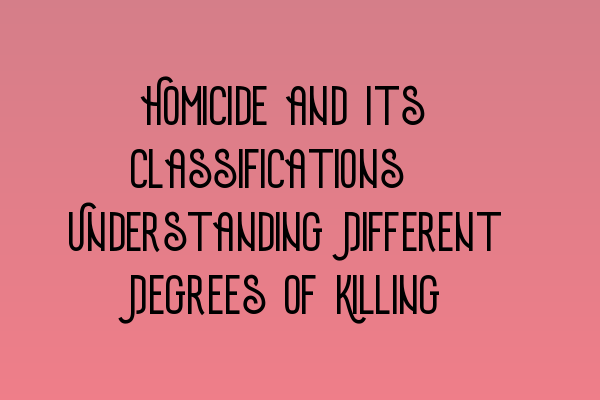Homicide and Its Classifications: Understanding Different Degrees of Killing
When it comes to criminal law, one of the most serious offenses an individual can commit is homicide. Homicide refers to the act of killing another person, but not all homicides are considered to be of the same severity. There are different degrees of killing, each with its own legal implications.
1. Murder
Murder is the most serious form of killing, usually involving premeditation or malice aforethought. It occurs when a person intentionally causes the death of another person with the intent to kill or cause serious bodily harm. In most jurisdictions, murder is classified into two degrees – first-degree murder and second-degree murder.
First-degree murder typically refers to intentional killings that are planned and deliberate. It is often accompanied by aggravating factors such as the use of a deadly weapon, the killing of a police officer, or the murder occurring during the commission of another serious crime. First-degree murder carries severe penalties, including life imprisonment or even the death penalty in some jurisdictions.
Second-degree murder, on the other hand, involves intentional killings that lack premeditation or occur in the heat of the moment. It may also include killings that result from reckless behavior without any specific intent to cause death. Second-degree murder often carries lesser penalties compared to first-degree murder, but still significant enough to have a substantial impact on the offender’s life.
2. Manslaughter
Manslaughter, unlike murder, generally does not involve the element of malice aforethought. It refers to the unlawful killing of another person without premeditation or the intent to cause death. The key distinction between manslaughter and murder lies in the absence of malice or premeditation.
Voluntary manslaughter occurs when a person intentionally causes the death of another person in response to adequate provocation, such as sudden and intense rage or fear. The provocation must be of a kind to cause a reasonable person to lose self-control. While voluntary manslaughter is a serious offense, the penalties are typically less severe than those associated with murder.
Involuntary manslaughter, on the other hand, refers to unintentional killings resulting from reckless or negligent behavior. It can occur in situations where an individual behaves in a manner that disregards the risks and consequences, leading to the death of another person. Involuntary manslaughter often carries lighter penalties compared to voluntary manslaughter or murder.
3. Infanticide
Infanticide is a separate offense that typically applies to the killing of a child aged one year or younger by their mother. It is a complex area of law and is rooted in the recognition that mothers may be suffering from mental health issues or facing unique challenges surrounding childbirth and postpartum problems. Infanticide laws aim to provide an alternative charge for such cases, taking into account the specific circumstances and potential mitigating factors.
Understanding the different degrees of killing is crucial in the study and practice of criminal law. It helps determine the appropriate charges, penalties, and defenses that may be applicable in homicide cases.
For more information on related topics, please check out our articles on:
- SQE 1 Practice Exam Questions
- SQE 1 Practice Mocks FLK1 FLK2
- SQE 2 Preparation Courses
- SQE 1 Preparation Courses
- SRA SQE Exam Dates
If you have any questions or need legal assistance regarding homicide or any other criminal law matters, please don’t hesitate to contact us. Our team of expert solicitors is here to help you navigate the complexities of the legal system.
